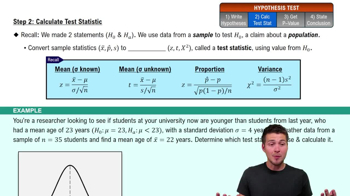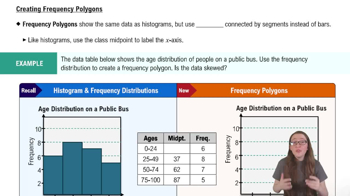Tornado Alley Construct the relative frequency distribution corresponding to the frequency distribution in Exercise 1
Table of contents
- 1. Intro to Stats and Collecting Data1h 14m
- 2. Describing Data with Tables and Graphs1h 55m
- 3. Describing Data Numerically2h 5m
- 4. Probability2h 16m
- 5. Binomial Distribution & Discrete Random Variables3h 6m
- 6. Normal Distribution and Continuous Random Variables2h 11m
- 7. Sampling Distributions & Confidence Intervals: Mean3h 23m
- Sampling Distribution of the Sample Mean and Central Limit Theorem19m
- Distribution of Sample Mean - Excel23m
- Introduction to Confidence Intervals15m
- Confidence Intervals for Population Mean1h 18m
- Determining the Minimum Sample Size Required12m
- Finding Probabilities and T Critical Values - Excel28m
- Confidence Intervals for Population Means - Excel25m
- 8. Sampling Distributions & Confidence Intervals: Proportion1h 12m
- 9. Hypothesis Testing for One Sample3h 29m
- 10. Hypothesis Testing for Two Samples4h 50m
- Two Proportions1h 13m
- Two Proportions Hypothesis Test - Excel28m
- Two Means - Unknown, Unequal Variance1h 3m
- Two Means - Unknown Variances Hypothesis Test - Excel12m
- Two Means - Unknown, Equal Variance15m
- Two Means - Unknown, Equal Variances Hypothesis Test - Excel9m
- Two Means - Known Variance12m
- Two Means - Sigma Known Hypothesis Test - Excel21m
- Two Means - Matched Pairs (Dependent Samples)42m
- Matched Pairs Hypothesis Test - Excel12m
- 11. Correlation1h 6m
- 12. Regression1h 50m
- 13. Chi-Square Tests & Goodness of Fit1h 57m
- 14. ANOVA1h 57m
2. Describing Data with Tables and Graphs
Frequency Distributions
Problem 11.1.25a
Textbook Question
Testing Goodness-of-Fit with a Normal Distribution Refer to Data Set 1 “Body Data” in Appendix B for the heights of females.

a. Enter the observed frequencies in the table above.
 Verified step by step guidance
Verified step by step guidance1
Step 1: Review the provided table and identify the height intervals: 'Less than 155.45', '155.45 – 162.05', '162.05 – 168.65', and 'Greater than 168.65'. These intervals will be used to categorize the observed frequencies.
Step 2: Refer to Data Set 1 'Body Data' in Appendix B to extract the heights of females. Count the number of observations that fall into each height interval.
Step 3: For each interval, tally the observed frequencies by counting how many data points fall within the specified range. For example, count all heights less than 155.45 for the first interval.
Step 4: Enter the observed frequencies into the table under the 'Frequency' row corresponding to each height interval.
Step 5: Verify the total frequency by summing up the values entered in the table to ensure it matches the total number of observations in the data set.
 Verified video answer for a similar problem:
Verified video answer for a similar problem:This video solution was recommended by our tutors as helpful for the problem above
Video duration:
2mPlay a video:
Was this helpful?
Key Concepts
Here are the essential concepts you must grasp in order to answer the question correctly.
Goodness-of-Fit Test
A goodness-of-fit test is a statistical hypothesis test used to determine how well a sample distribution fits a theoretical distribution. In this context, it assesses whether the observed frequencies of female heights align with the expected frequencies under a normal distribution. This test helps to evaluate the appropriateness of the normal model for the given data.
Recommended video:
Guided course

Step 2: Calculate Test Statistic
Observed Frequencies
Observed frequencies refer to the actual counts of occurrences in each category of a dataset. In the context of the question, these frequencies represent the number of females whose heights fall within specified ranges. Accurately entering these observed frequencies is crucial for conducting the goodness-of-fit test and comparing them against expected frequencies.
Recommended video:

Creating Frequency Polygons
Normal Distribution
A normal distribution is a continuous probability distribution characterized by its bell-shaped curve, defined by its mean and standard deviation. It is significant in statistics because many real-world phenomena, including human heights, tend to follow this distribution. Understanding the properties of normal distribution is essential for interpreting the results of the goodness-of-fit test.
Recommended video:
Guided course

Finding Standard Normal Probabilities using z-Table

 6:38m
6:38mWatch next
Master Intro to Frequency Distributions with a bite sized video explanation from Patrick
Start learningRelated Videos
Related Practice
Textbook Question
